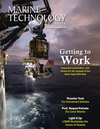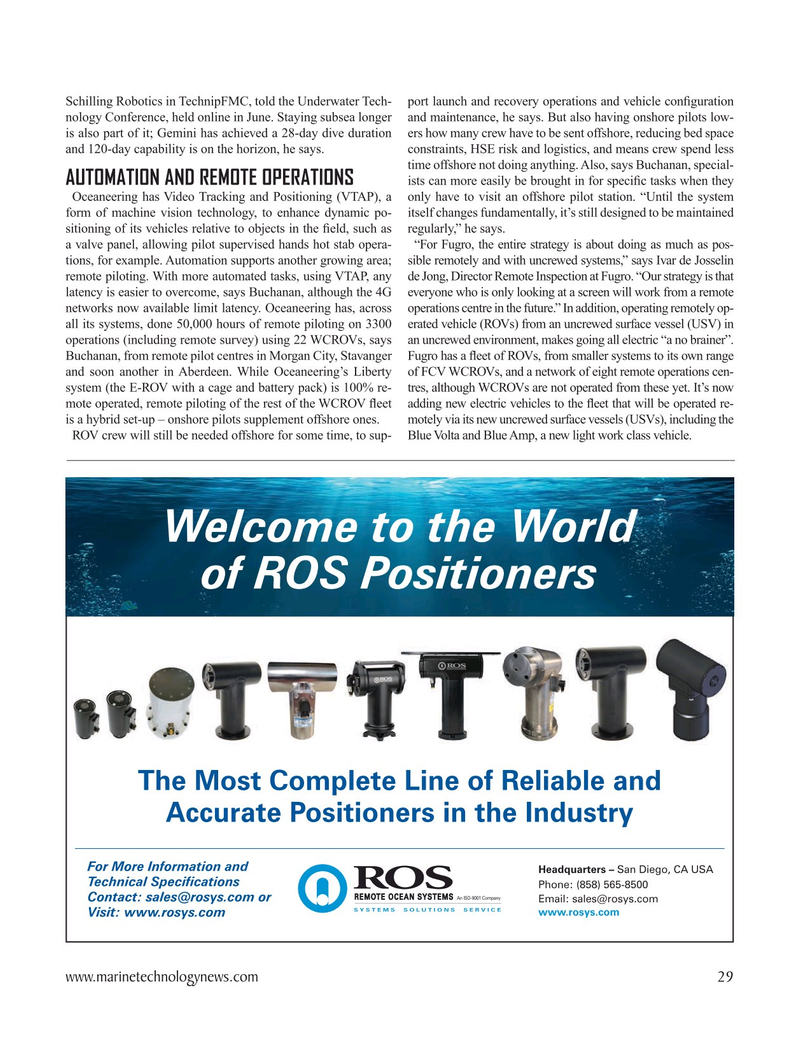
Page 29: of Marine Technology Magazine (July 2021)
Autonomous Vehicle Operations
Read this page in Pdf, Flash or Html5 edition of July 2021 Marine Technology Magazine
Schilling Robotics in TechnipFMC, told the Underwater Tech- port launch and recovery operations and vehicle con? guration nology Conference, held online in June. Staying subsea longer and maintenance, he says. But also having onshore pilots low- is also part of it; Gemini has achieved a 28-day dive duration ers how many crew have to be sent offshore, reducing bed space and 120-day capability is on the horizon, he says. constraints, HSE risk and logistics, and means crew spend less time offshore not doing anything. Also, says Buchanan, special-
AUTOMATION AND REMOTE OPERATIONS ists can more easily be brought in for speci? c tasks when they
Oceaneering has Video Tracking and Positioning (VTAP), a only have to visit an offshore pilot station. “Until the system form of machine vision technology, to enhance dynamic po- itself changes fundamentally, it’s still designed to be maintained sitioning of its vehicles relative to objects in the ? eld, such as regularly,” he says. a valve panel, allowing pilot supervised hands hot stab opera- “For Fugro, the entire strategy is about doing as much as pos- tions, for example. Automation supports another growing area; sible remotely and with uncrewed systems,” says Ivar de Josselin remote piloting. With more automated tasks, using VTAP, any de Jong, Director Remote Inspection at Fugro. “Our strategy is that latency is easier to overcome, says Buchanan, although the 4G everyone who is only looking at a screen will work from a remote networks now available limit latency. Oceaneering has, across operations centre in the future.” In addition, operating remotely op- all its systems, done 50,000 hours of remote piloting on 3300 erated vehicle (ROVs) from an uncrewed surface vessel (USV) in operations (including remote survey) using 22 WCROVs, says an uncrewed environment, makes going all electric “a no brainer”.
Buchanan, from remote pilot centres in Morgan City, Stavanger Fugro has a ? eet of ROVs, from smaller systems to its own range and soon another in Aberdeen. While Oceaneering’s Liberty of FCV WCROVs, and a network of eight remote operations cen- system (the E-ROV with a cage and battery pack) is 100% re- tres, although WCROVs are not operated from these yet. It’s now mote operated, remote piloting of the rest of the WCROV ? eet adding new electric vehicles to the ? eet that will be operated re- is a hybrid set-up – onshore pilots supplement offshore ones. motely via its new uncrewed surface vessels (USVs), including the
ROV crew will still be needed offshore for some time, to sup- Blue Volta and Blue Amp, a new light work class vehicle. :HOFRPHWRWKH:RUOG
RI5263RVLWLRQHUV 7KH0RVW&RPSOHWH/LQHRI5HOLDEOHDQG $FFXUDWH3RVLWLRQHUVLQWKH,QGXVWU\ )RU0RUH,QIRUPDWLRQDQG +HDGTXDUWHUV²6DQ'LHJR&$86$ 7HFKQLFDO6SHFLILFDWLRQV 3KRQH &RQWDFWVDOHV#URV\VFRPRU (PDLOVDOHV#URV\VFRP
ZZZURV\VFRP 9LVLWZZZURV\VFRP www.marinetechnologynews.com 29
MTR #5 (18-33).indd 29 7/30/2021 6:20:14 PM

 28
28

 30
30
